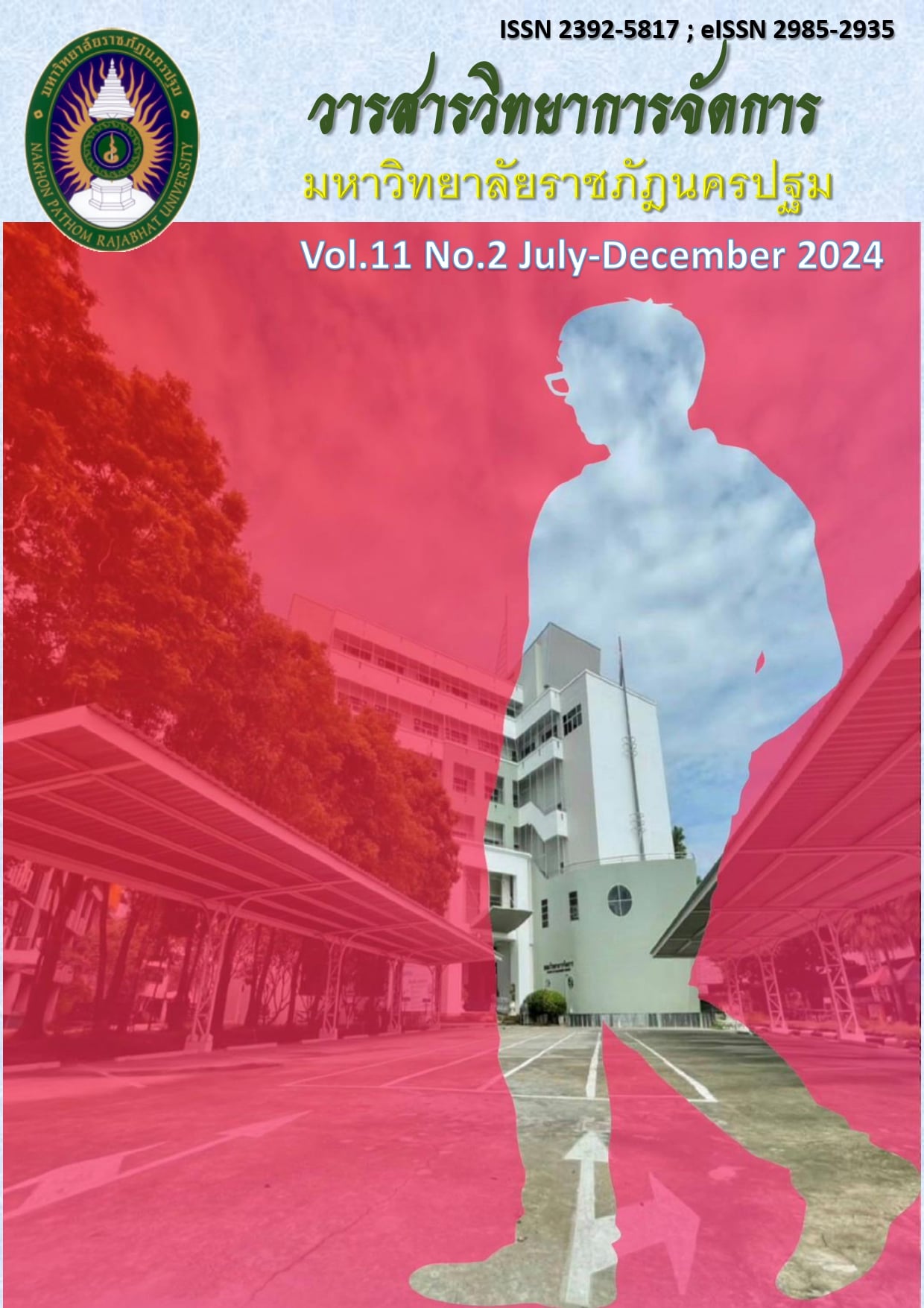Improving the Efficiency and Effectiveness of the Media Literacy instructional media: Case study Faculty of Management Science Nakhon Pathom Rajabhat
Main Article Content
Abstract
The objectives of this research are: 1. Study the efficiency level of media literacy teaching media 2. Study recommendations for the development of media literacy teaching kits. The population of the research was 104 students in the field of Communication Arts and International Business, second semester of the academic year 2023. This research was a quantitative research. The tools used were tests. The statistics used for data analysis were percentage, mean, and standard deviation. Data from open-ended questions were analyzed using content analysis.
The research results found that 1) The efficiency level of media literacy teaching media was at a high level overall. When considering each aspect, all aspects were equally at a high level of efficiency, such as media value/quality assessment (X=4.20), media access skills (X=4.16), media impact understanding (X=4.16), media utilization (X=4.16), media analysis (X=4.04), and media content interpretation (X=3.79). 2) Recommendations for the development of media literacy teaching kits were as follows: 1.Images should be used. and use a clearer voice 2. The media should be presented in more detail 3. Good media should be introduced 4. Media should be categorized 5. Media should be presented for a longer period of time and 6. There should be more channels for teaching different languages.
Article history: Received 25 May 2024
Revised 17 December 2024
Accepted 19 December 2024
SIMILARITY INDEX = 12.65 %
Article Details

This work is licensed under a Creative Commons Attribution-NonCommercial-NoDerivatives 4.0 International License.
The views and opinions of the article appearing in this journal are those of the author. It is not considered a view and responsibility of the editorial staff.
References
ชุติมา แก้วศรีงาม และ จิตรา กุลปภาวงศ์. (2564). การออกแบบสื่อการสอนหลายภาษาเพื่อเพิ่มการเข้าถึง
การรู้เท่าทันสื่อในกลุ่มผู้เรียนที่หลากหลาย. วารสารการศึกษานานาชาติ, 5(2), 82-98.
ณัฐวุฒิ ราชรักษ์. (2563). "การพัฒนารูปแบบการเรียนรู้โดยการแยกประเภทสื่อสำหรับนักเรียนระดับ
ประถมศึกษา." วารสารวิทยาการการเรียนรู้, 7(2), 95-112.
ทอแสงรัศมี ถีถะแกว. (2561). ประสิทธิภาพและประสิทธิผลของสื่อที่ใช้ในการจัดการเรียนการสอน เรื่อง
การรู้เท่าทันสื่อ: กรณีศึกษานักศึกษาวิชา RSU 101 ธรรมาธิปไตย สถาบัน General Education
มหาวิทยาลัยรังสิต. การประชุมวิชาการระดับชาติ มหาวิทยาลัยรังสิต, ประจําปี 2561 (RSU
National Research Conference 2018) [ออนไลน์] ค้นเมื่อ 25 มีนาคม 2567 จาก
https://rsucon.rsu.ac.th/files/proceedings/nation2018/G5-NA18-042.pdf
นิพนธ์ กิตติพร. (2565). การรู้เท่าทันสื่อ: ปัจจัยที่ส่งผลต่อการพัฒนาทักษะการคิดวิเคราะห์ของนักศึกษา.
วารสารการวิจัยการสื่อสาร, 10(2), 45-58.
ประภาพร สุขุม และ พรทิพย์ คงสมบูรณ์. (2565). การพัฒนาชุดการสอนรู้เท่าทันสื่อเพื่อเสริมสร้างการ
ประเมินคุณค่าของสื่อสำหรับเยาวชน. วารสารวิจัยและพัฒนานวัตกรรมการศึกษา, 9(1), 25-42.
ธนากร ภูผา และ ธัญลักษณ์ เกียรติสุพงศ์. (2566). การพัฒนาหลักสูตรสื่อการเรียนรู้เพื่อสนับสนุนการเลือก
สื่อที่มีคุณภาพและเหมาะสมในวัยรุ่น. วารสารการศึกษาและพัฒนาสังคม, 20(1), 37-53.
วรพจน์ ตะลุนลม. (2565). การพัฒนาหลักสูตรสื่อการสอนที่มีระยะเวลานำเสนอเหมาะสมสำหรับผู้เรียน
ระดับมัธยมศึกษา. วารสารศึกษาศาสตร์และการวิจัย, 10(3), 123-138.
มาริษา สุจิตวนิช.และเยาวภา บัวเวช. (2558). รายงานการวิจัยเรื่อง การวิจัยการรู้เท่าทันสื่อ : ประโยชน์
และการนำไปใช้ของนักศึกษาสาขานิเทศศาสตร์ คณะวิทยาการจัดการ มหาวิทยาลัยราชภัฎนครปฐม.นครปฐม: มหาวิทยาลัยราชภัฏนครปฐม.
ศิริวรรณ แก้วอำไพ และ จิราภรณ์ บุญชุ่ม. (2564). "การพัฒนาสื่อการเรียนรู้ที่มีภาพประกอบและเสียงที่
ชัดเจนเพื่อพัฒนาทักษะการรู้เท่าทันสื่อสำหรับนักเรียนมัธยมศึกษาตอนต้น." วารสารวิชาการและ
วิจัยการศึกษา, 18(2), 54-68.
สมชาย บุญฤทธิ์. (2564). ผลกระทบของสื่อการเรียนการสอนที่เน้นการรู้เท่าทันสื่อต่อการพัฒนาทักษะการคิด
วิเคราะห์ในนักศึกษา. วารสารวิชาการสังคมศาสตร์, 8(3), 102-115.
สุนทรี ชัยพร. (2563). บทบาทของการรู้เท่าทันสื่อในยุคดิจิทัลและผลกระทบต่อพฤติกรรมการบริโภคข่าวสาร
ของนักศึกษา. วารสารการจัดการและสื่อสาร, 5(4), 35-48.
Livingstone, S., and Blum-Ross, A. (2020). Children's data and privacy in the digital age. Oxford University Press.
Maksl, A., Craft, S., Ashley, S., and Miller, D. (2020). "The Impact of Media Literacy Education
on Digital Information Literacy Skills." Journal of Media Literacy Education, 12(1), 35-47.
Martens, M., and Hobbs, R. (2021). "Evaluating the Role of Access Skills in Media Literacy
Competency." Media Studies Journal, 15(2), 87-101.
Merrill, M. D. (2002). First principles of instruction. Educational Technology Research and
Development, 50(3), 43-59.
Moussa-Inaty, J., Aissa, N. H., and Garcia-Sanchez, J. N. (2019). The effectiveness of
multimedia learning tools in educational environments. International Journal of
Education and Information Technologies, 14(2), 97-110.
Potter, W. J. (2004). Theory of media literacy: A cognitive approach. New York: Sage
Publications.
Schmidt, H. C. (2012). Media literacy education in the social studies: Teacher perceptions and
curricular challenges. The Journal of Social Studies Research, 36(3), 237-255.
Silverblatt, A. and Eliceiri, E. M. E. (1997). Dictionary of Media Literacy. Santa Barbara, CA
Greenwood Publishing Group
Silverblatt, A. (2014). Media Literacy: Keys to Interpreting Media Messages. Praeger.
Tufte, T., and Enghel, F. (2017). Communication and Social Change: A Citizen Perspective.
Chichester, UK: Wiley-Blackwell.


